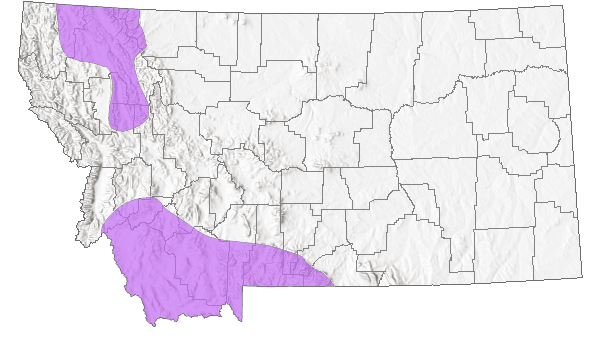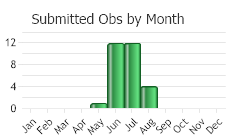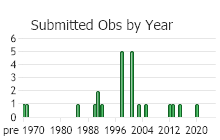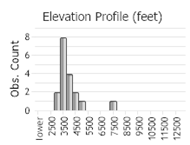View in other NatureServe Network Field Guides
NatureServe
Montana
Utah
Wyoming
Idaho
Wisconsin
British Columbia
South Carolina
Yukon
California
New York
Nagoonberry - Rubus arcticus
Other Names:
Rubus acaulis, Rubus arcticus ssp. acaulis
State Rank Reason (see State Rank above)
Rubus acaulis may be rare or common where its habitat is present. However, its habitat (hummocks in Sphagnum-moss dominated fens, high elevation wet-meadows, etc.) is very specific and often limited in Montana.
- Details on Status Ranking and Review
Range Extent
ScoreF - 20,000-200,000 sq km (~8,000-80,000 sq mi)
Area of Occupancy
ScoreD - 6-25 4-km2 grid cells
Number of Populations
ScoreB - 6 - 20
Number of Occurrences or Percent Area with Good Viability / Ecological Integrity
ScoreC - Few (4-12) occurrences with excellent or good viability or ecological integrity
Environmental Specificity
ScoreA - Very narrow. Specialist or community with key requirements scarce
Long-term Trend
ScoreU - Unknown
Trends
ScoreU - Unknown
Threats
ScoreU - Unknown
CommentNo known threats.
Intrinsic Vulnerability
ScoreA - Highly vulnerable
General Description
Plants: Perennial herb from a rhizome, seldom a little woody at the base; stems annual, upright, low-growing, unarmed (Douglas et al. 1999), glabrous to sparsely and finely hairy, 5-30 cm in length (FNA 2015).
Leaves: Deciduous, alternate, long-petioled, 2-5 per stem, with 3 lobes or leaflets; lobes or leaflets glabrous to hairy above, paler green and commonly hairy beneath (the veins generally with more hair), the margins coarsely dentate or bidentate; leaflets, when present, 10–50 mm long (Douglas et al. 1999); stipules ovate or narrowly so, 0.4-0.8 cm in length (FNA 2015).
Inflorescence: Axillary (FNA 2015), with 1-3 flowers at the end of leafy shoots (Douglas et al. 1999); pedicels smooth to somewhat hairy, with glands lacking or stipitate (FNA 2015).
Phenology
Flowers May-August (FNA 2015).
Species Range
Montana Range
Range Descriptions

 Native
Native
Range Comments
Canada: In all provinces and territories except NB, NS, and PE; USA: WA and OR, MT s to CO, MN, MI, and ME (FNA 2015).
Observations in Montana Natural Heritage Program Database
Number of Observations: 29
(Click on the following maps and charts to see full sized version)
Map Help and Descriptions
Relative Density

Recency



 (Observations spanning multiple months or years are excluded from time charts)
(Observations spanning multiple months or years are excluded from time charts)
Habitat
Boggy woods, fens, swamps, brush, damp tundra, alpine creek edges and grassy areas. Elevation: To 9840 feet (FNA 2015).
National Vegetation Classification System Groups Associated with this Species
Wetland and Riparian
Peatland
Riparian and Wetland Forest
Riparian Shrubland
Ecology
POLLINATORS The following animal species have been reported as pollinators of this plant species or its genus where their geographic ranges overlap:
Bombus vagans,
Bombus auricomus,
Bombus bifarius,
Bombus borealis,
Bombus centralis,
Bombus melanopygus,
Bombus mixtus,
Bombus rufocinctus,
Bombus ternarius,
Bombus sitkensis,
Bombus occidentalis,
Bombus pensylvanicus,
Bombus bimaculatus,
Bombus griseocollis,
Bombus impatiens,
Bombus insularis,
Bombus bohemicus, and
Bombus flavidus (Heinrich 1976, Thorp et al. 1983, Mayer et al. 2000, Wilson et al. 2010, Colla and Dumesh 2010, Colla et al. 2011, Koch et al. 2012, Williams et al. 2014).
Reproductive Characteristics
Flowers: Bisexual (FNA 2015); sepals 5, 5-13 mm in length, slenderly lanceolate, reflexed, with fine hair, occasionally glandular; petals 5, pink to purplish-red, obovate or narrower (Douglas et al. 1999), 8–25 mm in length (FNA 2015); stamens 30-40 (Douglas et al. 1999), with outer filaments widened at the base, the inner ones thread-like; pistils (10)15-30, smooth to slightly hairy (FNA 2015).
Fruit: A red or purple globose aggregate of 1-seeded, juicy drupelets, ca 1 cm across, the drupelets pulling away from the receptacle when ripe (thus referred to as a raspberry) (Douglas et al. 1999).
Stewardship Responsibility
References
- Literature Cited AboveLegend:
 View Online Publication
View Online Publication Colla, S., L. Richardson, and P. Williams. 2011. Bumble bees of the eastern United States. Washington, DC: USDA Forest Service, Pollinator Partnership. 103 p.
Colla, S., L. Richardson, and P. Williams. 2011. Bumble bees of the eastern United States. Washington, DC: USDA Forest Service, Pollinator Partnership. 103 p. Colla, S.R. and S. Dumesh. 2010. The bumble bees of southern Ontario: notes on natural history and distribution. Journal of the Entomological Society of Ontario 141:39-68.
Colla, S.R. and S. Dumesh. 2010. The bumble bees of southern Ontario: notes on natural history and distribution. Journal of the Entomological Society of Ontario 141:39-68. Douglas, G.W., D. Meidinger, and J. Pojar, editors. 1999. The Illustrated Flora of British Columbia. Volume 4. Dicotyledons (Orobanchaceae through Rubiaceae). British Columbia Ministry of Environment, Lands and Parks and British Columbia Ministry of Forests, Victoria.
Douglas, G.W., D. Meidinger, and J. Pojar, editors. 1999. The Illustrated Flora of British Columbia. Volume 4. Dicotyledons (Orobanchaceae through Rubiaceae). British Columbia Ministry of Environment, Lands and Parks and British Columbia Ministry of Forests, Victoria. Flora of North America Editorial Committee, eds. (FNA). 2014. Flora of North America North of Mexico. Vol. 9. Magnoliophyta: Picramniaceae to Rosaceae. New York, NY: Oxford University Press, Inc. 752 pp.
Flora of North America Editorial Committee, eds. (FNA). 2014. Flora of North America North of Mexico. Vol. 9. Magnoliophyta: Picramniaceae to Rosaceae. New York, NY: Oxford University Press, Inc. 752 pp. Koch, J., J. Strange, and P. Williams. 2012. Bumble bees of the western United States. Washington, DC: USDA Forest Service, Pollinator Partnership. 143 p.
Koch, J., J. Strange, and P. Williams. 2012. Bumble bees of the western United States. Washington, DC: USDA Forest Service, Pollinator Partnership. 143 p. Mayer, D.F., E.R. Miliczky, B.F. Finnigan, and C.A. Johnson. 2000. The bee fauna (Hymenoptera: Apoidea) of southeastern Washington. Journal of the Entomological Society of British Columbia 97: 25-31.
Mayer, D.F., E.R. Miliczky, B.F. Finnigan, and C.A. Johnson. 2000. The bee fauna (Hymenoptera: Apoidea) of southeastern Washington. Journal of the Entomological Society of British Columbia 97: 25-31. Thorp, R.W., D.S. Horning, and L.L. Dunning. 1983. Bumble bees and cuckoo bumble bees of California (Hymenoptera: Apidae). Bulletin of the California Insect Survey 23:1-79.
Thorp, R.W., D.S. Horning, and L.L. Dunning. 1983. Bumble bees and cuckoo bumble bees of California (Hymenoptera: Apidae). Bulletin of the California Insect Survey 23:1-79. Williams, P., R. Thorp, L. Richardson, and S. Colla. 2014. Bumble Bees of North America. Princeton, NJ: Princeton University Press. 208 p.
Williams, P., R. Thorp, L. Richardson, and S. Colla. 2014. Bumble Bees of North America. Princeton, NJ: Princeton University Press. 208 p. Wilson, J.S., L.E. Wilson, L.D. Loftis, and T. Griswold. 2010. The montane bee fauna of north central Washington, USA, with floral associations. Western North American Naturalist 70(2): 198-207.
Wilson, J.S., L.E. Wilson, L.D. Loftis, and T. Griswold. 2010. The montane bee fauna of north central Washington, USA, with floral associations. Western North American Naturalist 70(2): 198-207.
- Additional ReferencesLegend:
 View Online Publication
View Online Publication
Do you know of a citation we're missing? Culver, D.R. 1994. Floristic analysis of the Centennial Region, Montana. M.Sc. Thesis. Montana State University, Bozeman. 199 pp.
Culver, D.R. 1994. Floristic analysis of the Centennial Region, Montana. M.Sc. Thesis. Montana State University, Bozeman. 199 pp. Lesica, P., M.T. Lavin, and P.F. Stickney. 2012. Manual of Montana Vascular Plants. Fort Worth, TX: BRIT Press. viii + 771 p.
Lesica, P., M.T. Lavin, and P.F. Stickney. 2012. Manual of Montana Vascular Plants. Fort Worth, TX: BRIT Press. viii + 771 p. Lesica, P., M.T. Lavin, and P.F. Stickney. 2022. Manual of Montana Vascular Plants, Second Edition. Fort Worth, TX: BRIT Press. viii + 779 p.
Lesica, P., M.T. Lavin, and P.F. Stickney. 2022. Manual of Montana Vascular Plants, Second Edition. Fort Worth, TX: BRIT Press. viii + 779 p.
- Web Search Engines for Articles on "Nagoonberry"





